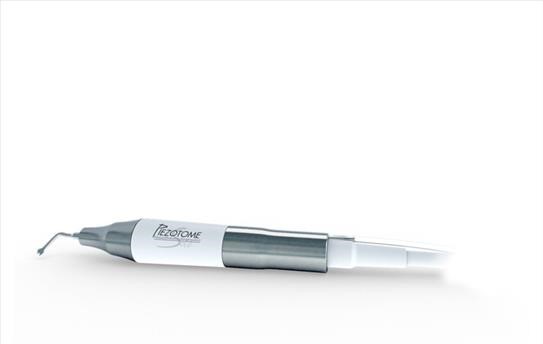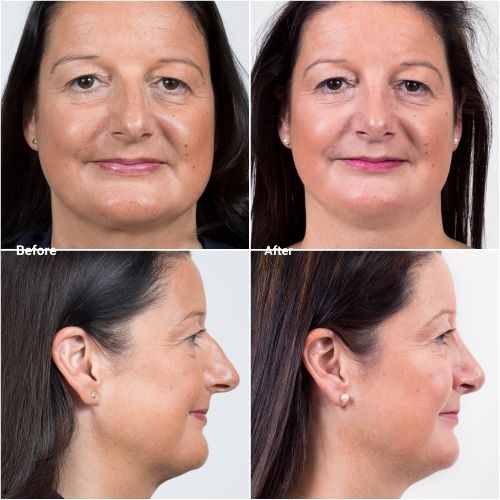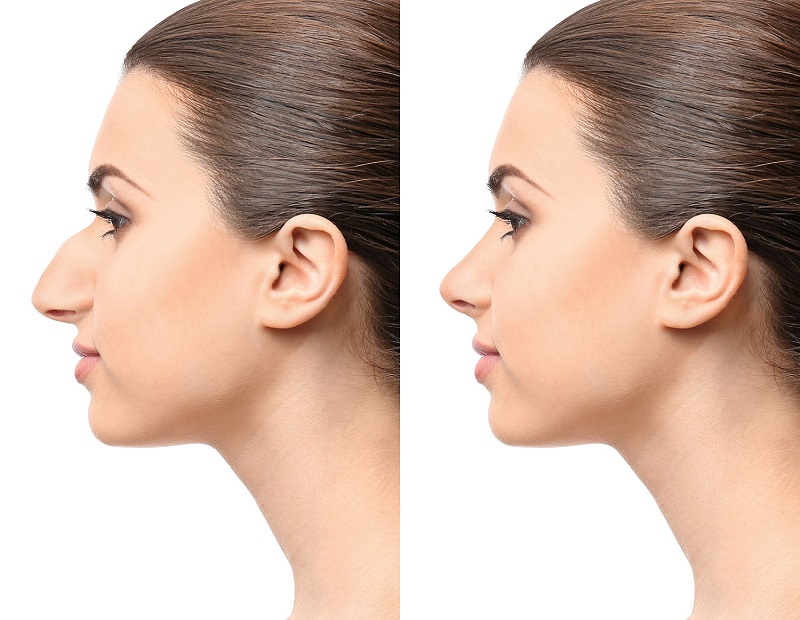Op.Dr. Evren AY KOÇ , a leading Rhinoplasty surgeon operating in Ataşehir, Istanbul, has countless case experiences.
Many people are self-conscious about the shape of their nose and choose to have Rhinoplasty for cosmetic reasons. Personal and emotional reasons often play a role in this choice. It could be because they don’t like the overall shape of their nose and want it to be smaller. Or they may want a ‘bump’ (nasal curvature) to be removed. They may dislike the width of their nostrils or want the tip of their nose to be thinner. Other patients may choose to have Rhinoplasty because of a nasal injury or breathing problems .
Whatever the reason, Rhinoplasty surgery is a delicate procedure that requires careful planning to achieve the desired result, in harmony with the rest of the face.
There are limits to how much a nose can be changed. Different physical characteristics, your age and ethnicity also affect how Rhinoplasty is performed. Op.Dr. Evren AY KOÇ , known as one of the leading Rhinoplasty surgeons in Istanbul, always takes your facial features into consideration when planning any surgery. During your initial consultation with him, you will undergo a full examination and discuss your nasal features in detail so that he can come up with an accurate plan for the surgery you need . You will also be asked about your general medical history, including details of any previous nasal injuries or corrective surgeries.
Rhinoplasty – (Nose surgery)
You can learn more about Rhinoplasty Surgery in the following sections .
RHINOPLASTY PROCEDURE
There are different techniques used in rhinoplasty surgery. These are known as the closed rhinoplasty approach, the open rhinoplasty approach, or the reduction rhinoplasty approach. All are performed under general anesthesia.
In a closed Rhinoplasty, the surgical incisions are made inside the nostrils so that there is no externally visible scar. However, while a visible scar is avoided, there are significant surgical challenges to this type of procedure as access to the nose is limited and a great deal of experience and skill is required by the surgeon.
An Open Rhinoplasty uses a small bridging incision along the columella ( the column of skin between the nostrils), which allows the nasal skin to be folded upward, allowing easier access to the inside of the nose .
Reduction Rhinoplasty , or a ‘nose job’, is used to reduce or increase the shape of the nose. It may also involve removing a ‘curvature’ or reshaping the tip, bridge or nostrils to create a new profile .
After surgery, surgical tape and/or a small cast will be needed to support and protect the nose for about a week, especially if the bones are settling into their new positions and bone additions are involved. During rhinoplasty , small dissolvable stitches are used inside the nose . You may also have external stitches, which are usually removed within a week.
Nasal packing may be necessary to prevent bleeding and to ensure the nasal lining adheres properly . As a result, you will usually need to breathe through your mouth for 24 hours or until normal breathing is restored, which is a very simple procedure. Even without packing, you will feel stuffy and unable to breathe properly through your nose. This is due to post -operative swelling and is very normal. If the actual airways have been operated on, it may take longer for the nose to heal and clear up completely.
RECOVERY AFTER RHINOPLASTY SURGERY
In most cases, Rhinoplasty surgery involves an overnight stay in the hospital. The next morning, you will be examined and nasal packing (if used) will be removed. If all is well, you can go home. Most patients take two weeks off work to recover.
After the operation, your nose will feel tight and sore, but surprisingly, pain is rare. If you need painkillers, your doctor can prescribe them. Aspirin or aspirin-like medicines (non-steroidal anti-inflammatory tablets) should not be taken.
It is important not to blow your nose or sneeze through your nose. You should avoid bending over or doing any activity for at least a week to reduce swelling and prevent any nosebleeds . You should not return to sports or heavy activity for 6 weeks.
Sleeping elevated with extra pillows will also help reduce swelling. In rare cases, your eyelids may become bruised and your eyes and face may swell after surgery. This may be related to the patient’s anatomy. Most of the swelling will subside within a few weeks, and delicate make-up can be applied to cover the bruising immediately after the cast is removed.
If you had a closed rhinoplasty , there will be no external stitches, but with an open rhinoplasty , there will be stitches along the central strut (columella). Although these stitches are dissolvable, the nurse may cut the ends of them after surgery . If you had a nostril reduction, there will be external stitches that will need to be removed after about a week. The scars will be a little red at first, but will fade into the natural shade of the nose. They will heal completely over time.
After surgery, surgical tape will cover the outside of your nose. A small cast may also be needed for about a week to support and protect your nose. After removal, tape may need to be applied over your nose for a few days to help control swelling while your nose heals.
It is normal for the nose to feel slightly numb after surgery, but sensation will return as the nerve supply to the skin renews itself over the next few months.
It can take several months for all the swelling to settle, so it’s important to understand that once the cast is removed, the shape of your new nose is not final. Scar tissue forms under the skin of your nose , and while it’s not visible, it can affect the shape. This scar maturation process takes an average of six months, sometimes longer, so you need to give your body the time it needs before the final result of your new nose becomes apparent.
RISKS RELATED TO RHINOPLASTY SURGERY
Infection and bleeding are possible, but recovery is normally straightforward. Serious complications are very rare. If you develop an infection, your doctor will prescribe a course of antibiotics.
It is very important that you do not have a cold or cough during your surgery. If you have any doubts or concerns, please discuss them with your doctor.
Rhinoplasty is a very specialized procedure and takes time to heal. As a result, approximately 10% of patients will require further healing. This is especially noticeable in noses that have suffered serious injuries or if there has been a significant reduction in the size of the nose . Your doctor will inform you if a second procedure is likely to be needed.
Most secondary procedures are usually a case of minor adjustments, but you should be aware that no surgery can be performed until it is safe to do so, typically 6 to 9 months after your initial surgery.
Your doctor, Evren AY KOÇ , will provide you with comprehensive information about Rhinoplasty after your first consultation .
Is rhinoplasty right for me?
Rhinoplasty surgery creates a permanent change in the shape of the nose, so before you go ahead with the surgery, it is very important to consider your reasons for wanting the surgery and how much a new nose will improve your confidence and health. If you are considering rhinoplasty , it is usually because there is a particular feature about your nose that you do not like. This will come up in the initial consultation with your doctor and will be fully discussed along with the possible outcome. The patient will always be strongly advised to think about what was discussed after the consultation to make sure they are fully informed about whether surgery is the right course of action for them. Often patients choose to have a second consultation to help them confirm things and ask additional questions. There will be no charge for the initial consultation or a second consultation and discussion for the patient who wants surgery .
How is recovery after rhinoplasty?
Recovery will depend largely on the extent of the procedure, but in general you will need to wear a nose cast for about a week and you may experience some facial bruising for a few weeks. It is very important to avoid physical exertion for about six weeks after surgery, as the swelling always gradually resolves on its own. After four to six weeks, most of the post- operative swelling will have subsided, but it can take several months for the long-term results to be seen. In some cases, it can take up to a year for all the tissues to fully settle and for the final result to be fully seen. If extensive work has been done on the tip of the nose , it may be particularly slow for the final results to be fully seen.
Is rhinoplasty painful?
Surprisingly, Rhinoplasty causes very little pain. In fact, it is one of the least painful cosmetic procedures. If there is any discomfort, it can be easily controlled with mild painkillers.
How do I choose a rhinoplasty surgeon?
No one needs emergency Rhinoplasty, so it is recommended that you take your time and find a surgeon that you like and trust. Only go to a surgeon who is properly trained and whose experience you trust. The most important factor is the experience of your surgeon. It is often difficult to judge a surgeon’s experience from their qualifications alone, so it is important to research as many examples of their work as possible, read patient testimonials, and look into other areas of rhinoplasty surgery experience ( Ear, Nose , Throat, Head and Neck Surgery). It is also very important not to choose a surgeon based solely on price. More experienced surgeons tend to quote a higher price for obvious reasons. In a face-to-face meeting, you will also get a good idea of whether the surgeon is right for you. In addition to understanding all of your reasons for wanting a rhinoplasty , they should be caring and reassuring.
What is Piezo Rhinoplasty?

What is Piezo Rhinoplasty ?
What is piezo rhinoplasty?
Piezo rhinoplasty is simply the technical name for ultrasonic rhinoplasty. This is a new form of rhinoplasty that avoids the hammer and chisel technique of reshaping the nasal bones . It allows for greater precision and reduces the unwanted trauma and soft tissue damage that can occur with traditional rhinoplasty techniques.
Op.Dr. Evren AY KOÇ has significant experience in Piezo rhinoplasty as one of the first surgeons to adopt this technique in our country .
How does piezo rhinoplasty work?
This form of rhinoplasty avoids the relatively crude instrumentation of hammers and chisels. Instead, a piezotome is used to reshape and reduce the size of the nasal bones. A piezotome is a specialized instrument that delivers ultrasonic energy to the bone without damaging the surrounding soft tissue. Because the energy is delivered specifically to the bone, there is no secondary damage, meaning less soft tissue swelling and bruising. The piezotome device comes with a variety of attachments that are shaped like sculpting tools used to reshape the bone.
What is the advantage of piezo rhinoplasty?
This is a gentler technique that allows the surgeon greater precision. There is less swelling and bruising, and some patients notice little to no bruising. The hammer and chisel technique can cause some fragmentation of the bone, which can inadvertently cause fractures. This is prevented with a piezotome. It also allows for shaping in a way that is not possible with fine files. In some cases, the nasal bones can even be prevented from breaking.
The technique also fits the modern trend of conservative rhinoplasty, a philosophy of reshaping tissue rather than destructively removing it during rhinoplasty , which was so common in older techniques . The piezotome can be used to reshape bone without breaking it, or it can be used to preserve the bridge of the nose .
Am I suitable for piezo rhinoplasty?
The instrumentation is designed for nasal bone shaping. Therefore, it is only suitable for patients who require reduction or adjustment of the nasal bones. This may include reduction of bony curvature, adjustment of bony deviations or bony irregularities, and narrowing of the bony mid-vault.
The technique is not suitable for nose tip and cartilage corrections , which are usually done using suture and graft techniques . The piezotome does not cut or reshape the cartilage, as only the high bone density allows energy transmission. Therefore, if you only need tip surgery, the piezotome is not suitable.
Another important factor to consider is that piezo rhinoplasty must be performed via an open approach and cannot be used via a closed or intranasal approach. This is because the instruments are not long enough and direct visualization of the bones is required for piezo bone shaping. However, the advantages of using a piezotome for rhinoplasty outweigh the minimal scarring that is not noticeable.
Why don’t all surgeons use Piezo rhinoplasty techniques?
This technique is not common because most surgeons are unfamiliar with this advanced form of equipment and how to adapt and modify standard rhinoplasty techniques to include the use of Piezotome technology. Additionally, Piezotome equipment is significantly more expensive.
What is the recovery after piezo rhinoplasty?
There is little or no pain after surgery. Bruising is also significantly reduced. A nasal splint is usually required to hold the nasal bones in place during the initial healing period . This is removed after about 1 week. Most patients will notice minimal or no bruising when the splint is removed.
However, it should be noted that since a number of different structures are altered during rhinoplasty , it can take up to a year to see the final result after full recovery. Unfortunately, there is no quick way to the final result, but there are definitely advantages in the precision of the technique, which benefits in the early recovery period and the quality of the results obtained.
What are the typical results?
The same patient 9 months after surgery.

After piezo rhinoplasty

After piezo rhinoplasty Pictures are examples.
Piezo rinoplasti sonrası Resimler örnektir.
